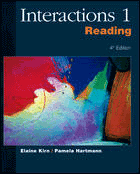 |  Interactions 1 Reading, 4e Elaine Kirn,
West Los Angeles College
Pamela Hartmann,
Los Angeles Unified School District
Before You Read A. Using Prereading Activities
Prereading is an important step to reading success. Prereading activities are designed to prepare students for the article that they are to read by getting them to start thinking about the topic and becoming familiar with some of the new vocabulary. The Interactions Mosaic series includes several types of prereading activities.
- Illustrations: The questions that accompany the illustrations are best handled in pairs so that students can talk and look at the picture(s) at the same time. This should be followed by a whole-class discussion.
- Prereading questions: Look at the questions beforehand. If you feel that students need some clarification, use the questions as the basis for a whole-class discussion. If they are personal questions, students might feel more comfortable discussing them in pairs or small groups and then sharing with the class.
- Whenever possible, personalize the questions for your students or add related questions about their experiences. In most cases, prereading should be a short activity. If students get caught up in a discussion, allow it to continue for a few minutes. Then table it until after the reading. They should have even more to say then.
B. Preteaching Vocabulary
In most cases, it is best not to preteach the vocabulary. Students can look at the list and check off the words that they already know. Then they should be looking for the unfamiliar words while they are reading. This method will allow them to practice one of the most important reading skills—guessing the meaning of words in context. Remember that if students cannot guess the meanings, you can always teach the words afterward.
There are activities that can be done with the lists of words.
- Use them to review suffixes and prefixes that students have already learned by asking students to use the suffixes to guess parts of speech or the prefixes to guess some part of the meaning. For example, un- means "not."
- If you feel that some words are absolutely essential for students to know before they begin, or if there are so many new words that they will feel overwhelmed, have them pool their knowledge. Twenty students know far more words than one does.
- Select a few words to be used as a dictionary activity with English-English dictionaries. Divide the class into groups. Give each group a couple of words and then have students share what they’ve learned.
|
|



 2002 McGraw-Hill Higher Education
2002 McGraw-Hill Higher Education

 2002 McGraw-Hill Higher Education
2002 McGraw-Hill Higher Education